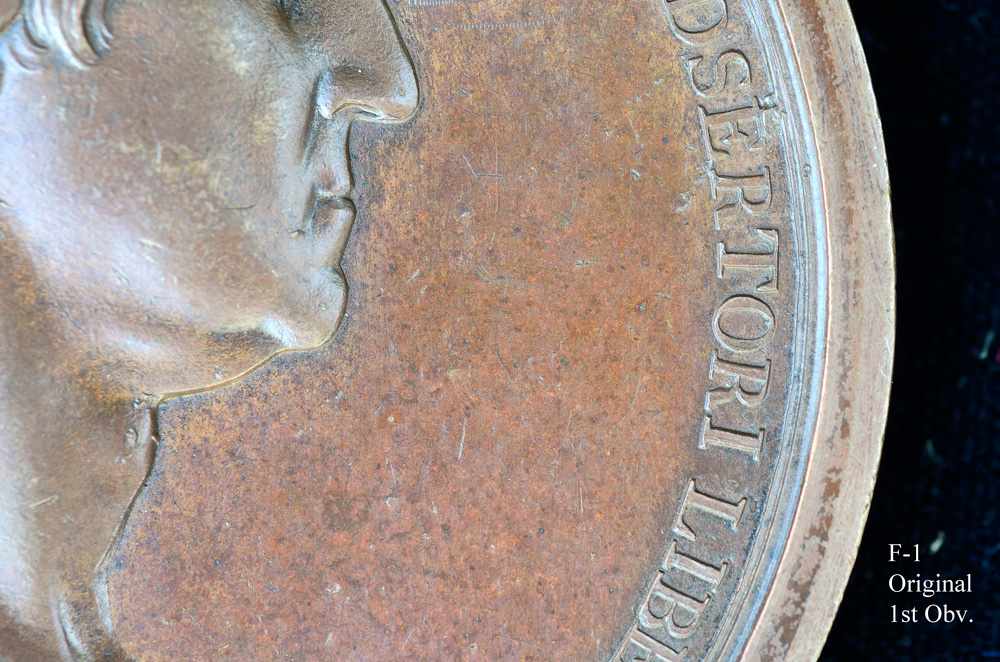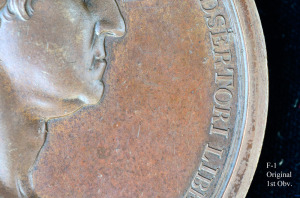Washington Before Boston Medal: A Die Emission Study Requires Direct Observation of the Medals Themselves

I am happy that my article about the Die Varieties of the Washington Before Boston medal has sent people back to their collections to look at the medals. I hope that more people will report their findings. A die emission sequence can only be theorized and verified by looking at the medals themselves.
John Adams’ recent report in the Esylum newsletter of October 7, 2012 that there are examples of F1 “that are from a later obverse die state than most of the F-2’s and F-2.1’s” would certainly make sense. The F-1, F-2 and F-2.1 could have been struck up to 1832 before the Paris Mint began using edge marks. If John Adams observations are correct, the die state of F-1 could mean the difference between whether a specimen of F1 was struck close to the time of George Washington’s gold medal or closer to 1832.
We know that the error reverse, F2 and the corrected error reverse, F2.1 did not experience much use. There are only 4 known error reverse, F2 (Scarinci, Menchell, Adams have 3 of the 4) and no more than 8 or 10 corrected error, F2.1 (Menchell & Adams account for 2 of them). The corrected error reverses, F2.1, that I have seen, all show die failure which accounts for why so few of them were struck. It is certainly possible that the Paris Mint reverted back to using the broken original reverse die, F-1, after the die failure of the F-2.1 reverse die resulting in a second emission of F-1. It is logical that the Paris Mint would have used whatever dies were available to fill orders until new dies, F-3, were prepared. Based on the current available information, F-3 is not known with a plain edge which means that F-3 was not in use before 1835.
It is important to note that the obverse die states on the 2 error reverse F-2 and the 2 corrected error reverse F-2.1 that I examined were all later than any F-1 obverse die state than I have seen. So John Adam’s use of the word “many” should be read with caution until verified. However, if you own a late obverse die state of F-1, you may own something made decades after Washington’s original gold medal was struck and late die states may come to be valued less, accordingly. Of course, right now the notion that F1 was struck up to 1832 is just speculation until visual die state evidence can be obtained and shared to prove that hypothesis.
I am posting an enlargement of the key diagnostic area of a relatively early state of the original obverse die, F-1 next to a very late state of the original obverse die, F-3 to help with the identification. The F-3 obverse was in use as late as 1888. We can verify that because it was used to strike a silver anniversary medal in the collection of a prominent New York Collector. We had the opportunity to compare that anniversary medal to the F3 plated here and the die state is the same.
The F3 pictured here is found with a cornucopia “Bronze” on the edge which dates it to 1880 or later.
John Adams and I completely agree that “Paris Mint employees of the time used these dies in an undisciplined, even whimsical, fashion.” In fact, they still do. As I point out in my article, this can be seen by the existence of F3 with edge marking dating them as early as 1845 and as late as 1880. We know that the die of F4 was used for the American Gunmetal die, US1, in 1863.
It is precisely this whimsical and imprecise use of dies by Paris Mint employees that has been the single greatest cause for confusion about these medals. The other two causes of confusion are of our own making.
The work that Adams and Mooney have done on this medal is extremely important and valuable to understand the history of this medal and its design. However, as to Mooney’s work, if anyone actually has a copy of it, you have a prize of numismatic literature, but keep it with your first edition of Breen’s Encyclopedia. It is a great piece of numismatic history and a great piece of scholarship, but the constant reference to it is ground zero for much of the confusion that exists about the die emission sequence of the Washington Before Boston medal.
Similarly, and equally luring to Mooney, is the collateral evidence such as the cliché owned by BPL “with the Error Reverse paired with the “U” reverse (which, because of Jefferson’s objection, was never used),” and the “framed set of shells in which the Error Reverse is paired with the obverse in a totally uninjured state” that is owned by the ANS to which John Adams refers. Absent a definitive reference to these items from someone in the Paris Mint at the time, there is no way to tell exactly why or when these items were made. The speculation about these and other pieces owned privately by collectors is interesting and these items are wonderful, but they offer little guidance for purposes of determining a die emission sequence of the medals.
As more collectors report their observations and their holdings, I will update my study here. Since no more than 60 of F1, F2 and F2.1 exist in bronze, perhaps it will even be possible to compile a census of these medals and where they are. However, I will stay away from ranking them according to condition and avoid the controversy that causes.

